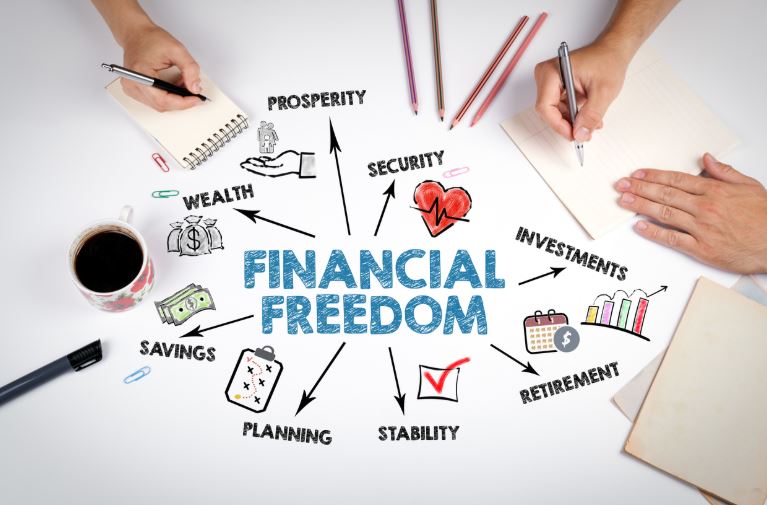Financial freedom means different things to different people, but deep down, we all want the same thing: a life where money is no longer a source of stress. A life where you choose what to do, where to go, and how to live—without financial pressure holding you back.
In this complete blog post, we’re going to break down what financial freedom really means, why it matters, and how you can create a step-by-step roadmap to achieve it. Grab a cup of coffee and get comfortable. This is your journey to a better, more empowered financial future.
What Is Financial Freedom?
Financial freedom is the point where your money works for you instead of you working for money. It means your savings, investments, and income sources are strong enough to cover your lifestyle without depending on a job or salary.
When you’re financially free:
- You never worry about bills.
- You have multiple income sources.
- You can retire when you want.
- You control your time.
- You live life based on choice, not necessity.
Financial freedom doesn’t mean you’re a millionaire. It means you’re secure, comfortable, and in control.
Why Financial Freedom Should Be Your Ultimate Goal
Everyone has dreams—travelling, buying a home, starting a business, helping family, giving to charity, or simply living without stress. Money affects all these dreams. When you’re financially free, everything becomes easier.
Here’s why it matters:
1. You Gain Peace of Mind
Financial stress is one of the biggest causes of anxiety. Being free from money worries brings mental peace.
2. You Control Your Time
Money buys time. When you have enough, you choose how your days look.
3. You Avoid Debt Traps
People with financial freedom don’t depend on high-interest loans. They use money wisely.
4. You Build Generational Wealth
Your children and family benefit from your discipline and planning.
5. You Live Life on Your Terms
Freedom means choices—work because you want to, not because you must.
The Levels of Financial Freedom
Financial freedom isn’t one destination. It has stages. You’ll probably recognise where you are right now.
1. Financial Dependence
You rely on others—family, loans, or a job—to survive.
2. Financial Stability
You cover your basic needs without borrowing.
3. Financial Breathing Room
You can save a little and handle small emergencies.
4. Debt-Free Living
You no longer owe toxic debt (credit cards, payday loans, etc.).
5. Financial Growth
Your investments start producing returns.
6. Financial Independence
You can live comfortably without a full-time job.
7. Financial Freedom
You earn more from passive income than your lifestyle requires.
8. Financial Abundance
You have more money than you need and can help others generously.
Wherever you are, you can move up with consistent effort.
Step 1: Redefine Your Relationship With Money
Before you can build wealth, you must fix how you think about money. Your mindset shapes your financial destiny.
Common Mindset Blocks:
- “Money is hard to make.”
- “I will always be broke.”
- “Only rich people can invest.”
- “I don’t earn enough to save.”
These beliefs limit your progress.
Shift to a Growth Mindset:
- “Money is a tool.”
- “I can learn new financial skills.”
- “I deserve a wealthy life.”
Financial freedom starts with your mindset, not your wallet.
Step 2: Track Your Spending Like a Pro
You can’t control what you don’t measure. Most people don’t know where their money goes. Tracking your expenses exposes the truth.
How to Track Spending Easily:
- Use budgeting apps.
- Keep a monthly expense sheet.
- Review your bank alerts.
- Cut unnecessary subscriptions.
If you want financial freedom, you must become aware of every dollar.
Step 3: Build a Budget That Actually Works
Budgeting is not punishment. It’s a plan for your money. Without a budget, financial freedom is impossible.
The 50/30/20 Budget Method:
- 50% for needs
- 30% for wants
- 20% for savings and investments
Choose a plan that fits your lifestyle, but stick to it.
Step 4: Crush Your Debt Intentionally
Debt steals your future wealth. High-interest loans trap millions of people every year. To reach financial freedom, you must eliminate toxic debt.
Two Powerful Debt Strategies:
Debt Snowball (Motivational Method):
Pay the smallest debts first.
Debt Avalanche (Smartest Method):
Pay debts with the highest interest first.
Whatever method you choose, stay consistent. Every debt you eliminate increases your financial power.
Step 5: Build an Emergency Fund
Emergencies are unavoidable. You need a safety net.
Your emergency fund should cover:
- 3 to 6 months of expenses
- Medical emergencies
- Job loss
- Car or home repairs
This fund stops emergencies from becoming financial disasters.
Step 6: Save Money Automatically
Saving becomes easy when you remove emotions and automate it. Set up automatic transfers to your savings and investment accounts so you never skip a month.
Smart Places to Save:
- High-yield savings accounts
- Money market accounts
- Certificates of deposit (CDs)
Start small, grow gradually, and stay consistent.
Step 7: Start Investing Early and Consistently
You cannot reach financial freedom through savings alone. Investing is the engine that grows your wealth.
Investing allows your money to multiply through compound interest.
Beginner-Friendly Investment Options:
- Index funds
- Mutual funds
- ETFs
- Dividend stocks
- Real estate
- Bonds
- Retirement accounts
Start where you are. Even ₦10,000 or $20 a month can grow into millions over time.
Step 8: Build Multiple Streams of Income
One income source is too risky. If you lose your job, everything collapses. Financial freedom requires multiple income streams.
Realistic income ideas:
- Freelancing
- Real estate
- Online businesses
- Affiliate marketing
- Side hustles
- Selling digital products
- Investing in stocks or crypto
- Rental services
- Dividends
The goal is to create income that grows even when you’re not working.
Step 9: Cut Unnecessary Expenses
Small leaks sink big ships. You don’t have to live like you’re poor, but you should avoid lifestyle inflation.
Common places people waste money:
- Impulse buying
- Unused subscriptions
- Eating out too often
- Buying to impress others
Control your spending and your wallet will reward you.
Step 10: Protect Your Wealth
Building wealth is one thing. Keeping it is another. Protect yourself with insurance, smart documentation, and estate planning.
Essential Protection Tools:
- Health insurance
- Life insurance
- Asset protection
- Legal documents
- Emergency planning
Financial freedom requires security.
Step 11: Surround Yourself With Financially Smart People
Your environment affects your financial habits. If your friends waste money, you might too. Surround yourself with people who inspire you to grow.
Key relationships to build:
- Financial mentors
- Accountants
- Business-minded friends
- Investors
Your network can speed up your journey to financial freedom.
Step 12: Keep Learning and Improving
The financial world changes constantly. You must stay updated. Learn new skills, understand markets, and keep improving your knowledge.
Where to learn:
- Books
- Podcasts
- YouTube
- Online courses
- Workshops
Knowledge builds confidence, and confidence builds wealth.
Practical Example: A Simple Roadmap to Financial Freedom
Let’s imagine you start with nothing. Here’s a simple action plan:
Year 1:
- Track spending.
- Build a budget.
- Create an emergency fund.
- Pay off small debts.
Year 2:
- Pay off major debts.
- Start investing.
- Learn a new skill.
- Start a side hustle.
Year 3:
- Increase investments.
- Build multiple income streams.
- Reduce expenses further.
Years 5–10:
- Achieve financial independence.
- Build passive income.
- Buy assets.
- Plan early retirement.
This roadmap works for anyone.
Habits of People Who Achieve Financial Freedom
1. They spend less than they earn.
This is the foundation of wealth.
2. They invest consistently.
They allow their money to grow.
3. They avoid bad debt.
They borrow only to build wealth, not to impress others.
4. They plan for the long term.
They don’t chase quick money.
5. They educate themselves.
Knowledge protects them from costly mistakes.
6. They stay disciplined.
Consistency beats intelligence every time.
Signs You’re on the Path to Financial Freedom
You’ll know you’re progressing when:
- You no longer panic when bills arrive.
- You have savings and investments.
- You pay for things comfortably.
- You don’t depend on loans.
- You can help others.
- You feel secure.
These signs show you’re no longer controlled by money.
Conclusion
Financial freedom isn’t a myth. It isn’t luck. It’s a series of intentional choices that anyone can make. When you take control of your money, you take control of your life. You gain peace, stability, choices, confidence, and the ability to build a better future.
Start today.
Don’t wait.
Take the first step—no matter how small.
With consistency, courage, and commitment, financial freedom becomes not just possible but inevitable. Your best financial life is waiting for you. Go get it.










